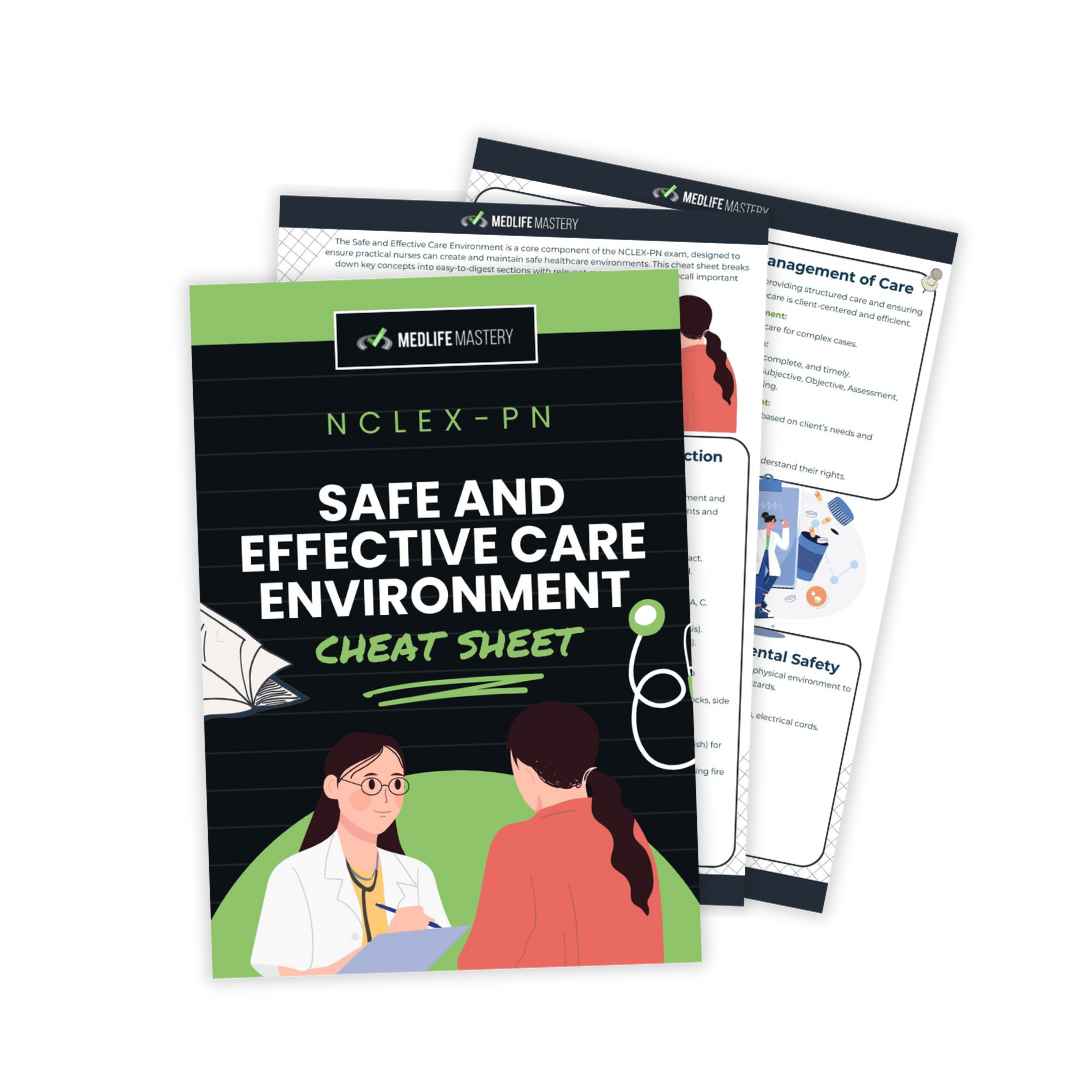
Safe and Effective Care Environment PN Cheat Sheet - Free PDF Download

Let’s get straight to it: Safe and Effective Care Environment in NCLEX-PN sounds like a mouthful, but it’s one of the most practical sections of the exam. This category doesn’t just test what you know—it challenges you to think like a nurse. It focuses on how to keep patients safe and deliver care without a hitch.
It also makes up roughly 21–33 percent of the exam, making it a powerful test. This section has the phrase high payoff written all over it if you want something to master.
In reality, what does it mean? Imagine a day in which everything goes without a hitch. Nurses stay on top of their work, patients feel safe, and errors are rare. This isn't just fantasy. This section wants you to accomplish precisely that.
Let’s unpack this category step by step, like you’re tackling a puzzle with the answers right in front of you.
What Is the Safe and Effective Care Environment in NCLEX-PN?
Think of this section as a two-part story. The first part focuses on Management of Care, which covers patient advocacy, task prioritization, and ethical responsibilities. The second part zeroes in on Safety and Infection Control, where the goal is to prevent harm.
Together, they create a framework for nurses to deliver top-notch care without cutting corners or risking safety.
Here’s how it looks:
Why Does This Matter?

Let me throw a real-world scenario at you. A nurse notices that a new patient’s chart doesn’t include a signed consent form for surgery scheduled in an hour. What should they do? This is where Safe and Effective Care Environment in NCLEX-PN comes into play. It arms you with the tools to handle moments like this calmly and confidently.
Mistakes in healthcare have serious consequences. You are preparing to make decisions that safeguard patients and foster trust in every encounter by concentrating on this domain, not just passing a test.
Breaking Down the Key Concepts
The primary elements of the Safe and Effective Care Environment in NCLEX-PN are simplified in this section. It highlights crucial nursing procedures that guarantee patient safety and effective treatment.
1. Management of Care: The Heart of Organized Nursing
This section is all about maintaining organization and standing up for your patients. It blends the emotional and rational aspects of nursing. You will manage the legal aspects of care balance tasks and make sure patients' voices are heard. Let's take a look at it.
Patient Advocacy
Advocacy entails speaking for the patient. Perhaps they are unsure of a decision or do not fully comprehend their treatment plan. You must intervene and make sure their needs come first. This is how it appears:
Prioritization of Care
Nursing can feel like a juggling act, but knowing what comes first makes all the difference. Use frameworks like the ABCs (Airway, Breathing, Circulation) to identify what needs attention immediately. For instance, a patient struggling to breathe comes before one asking for pain meds.
Delegation and Supervision
You can’t do everything alone, and that’s where delegation steps in. But it’s not a free-for-all. You need to know what tasks require your clinical judgment and what can safely go to a UAP (unlicensed assistive personnel).
For example:
2. Safety and Infection Control: Keeping Everyone Out of Harm’s Way
Safety goes beyond wearing gloves or wiping down a tray. It’s a mindset that shapes every action you take as a nurse.
Standard Precautions
Treat all bodily fluids as potentially infectious. Always wear gloves when coming into contact with them. Wash hands thoroughly before and after patient care. This isn’t optional—it’s the first line of defense against spreading infection.
Isolation Protocols
Every nurse should know how to set up isolation precautions. This ensures patients with contagious diseases don’t infect others. For example:
Fall Prevention
Patient falls aren’t just accidents—they’re preventable. Lower bed heights, use non-slip footwear, and make sure call buttons are within reach. These simple measures save lives and prevent injuries.
How to Tackle NCLEX-PN Questions in This Category

Learn effective strategies to confidently answer Safe and Effective Care Environment questions. Focus on prioritizing actions and avoiding common pitfalls in exam scenarios.
1. Focus on the Core Issue
Questions often include unnecessary details. Your job is to filter through the noise and figure out what really matters. Stick to the facts, and avoid second-guessing yourself.
2. Prioritize Actions
If a question asks what to do first, think about what prevents the most harm. The ABCs work well here, especially in emergency scenarios.
3. Avoid Traps
Some answers might seem right but miss the mark. For instance, delegating vital sign monitoring after a high reading sounds fine, but you’re the one who needs to confirm abnormal findings.
Key Scenarios You Need to Know
Explore practical examples that mirror real-life nursing situations. Know how to use your knowledge to handle important situations confidently.
Scenario 1: Delegating Tasks
Suppose a UAP finds that a patient has a blood pressure reading of 200/120. No way. Can you assign the recheck? A nurse's knowledge is required for critical readings. It is up to you to verify the figures and choose what to do next.
Scenario 2: Infection Control
You witness a coworker going into a patient's room without gloves. What are you going to do? Stop them right away. The patient's safety comes first, even if speaking up is uncomfortable.
Study Tips for Mastering This Section
Learn practical strategies for remembering important ideas and enhancing your test-taking abilities. Gain self-assurance by using tried-and-true methods that simplify difficult subjects.
1. Use Mnemonics
Tricks like “ABC” (Airway, Breathing, Circulation) make prioritization easier to remember.
2. Practice Realistic Questions
Tricks like “ABC” (Airway, Breathing, Circulation) make prioritization easier to remember.
3. Understand the “Why”
Rules stick better when you know the reason behind them. For instance, understanding why we use sterile techniques during catheter insertions helps you apply the concept in different contexts.
Common Pitfalls to Avoid
Identify mistakes that can derail your performance on Safe and Effective Care Environment questions. Stay prepared by knowing what to watch out for and how to avoid them.
Patient Rights and Ethical Practice: Navigating the Grey Areas

Ethical dilemmas in nursing aren’t rare—they’re a daily part of the job. Patients rely on you to protect their rights and guide them through healthcare’s often overwhelming processes. The NCLEX-PN includes these concepts because they’re foundational to safe and effective care.
When you understand the ethical responsibilities tied to patient care, you’ll feel more confident making tough calls.
Core Patient Rights Every Nurse Should Know
Every patient has specific rights, and as a nurse, you stand on the frontlines of protecting them. Here’s a quick breakdown:
Understanding Ethical Practice in Nursing
Ethics revolves around doing the right thing while balancing medical, legal, and emotional factors. You’ll encounter moments when the “right” answer isn’t obvious.
Let’s take a closer look:
Practical Scenarios You Might Face
How This Shows Up on the NCLEX-PN
You’ll often encounter questions testing your understanding of patient rights and ethics. These questions assess whether you respect autonomy, prioritize fairness, and follow legal guidelines. Look for key phrases like “advocate for the patient” or “best course of action.”
By mastering ethical practice, you’ll not only score high on the exam but also develop the emotional intelligence to thrive as a nurse.
Disaster and Emergency Preparedness: Staying Calm Under Pressure
Emergencies don’t announce themselves. Whether it’s a fire in the hospital or an influx of patients during a natural disaster, nurses play a critical role in maintaining order and saving lives. The NCLEX-PN includes questions on disaster preparedness because it’s vital for safe and effective care.
Understanding Disaster and Emergency Protocols
Disasters can range from environmental crises like hurricanes to internal emergencies like power outages. Nurses need to know how to act fast while staying organized. Key protocols to remember include:
Common Emergency Scenarios and Responses
Infection Control in Emergencies
Emergencies often increase infection risks, especially in overcrowded conditions. Follow these steps to prevent outbreaks:
How This Shows Up on the NCLEX-PN
Disaster preparedness questions often involve situational problem-solving. For example: “You’re working during a flood, and the power goes out. What’s your first action?” Focus on protocols that maintain patient safety and preserve critical resources.
Why Preparedness Matters
Emergencies happen when they happen. Knowing these protocols will help you react correctly in stressful situations. When it comes to disaster preparedness, maintaining composure and saving lives in dire circumstances are more important than passing the NCLEX.
Conclusion: Master the Safe and Effective Care Environment in NCLEX-PN

The Safe and Effective Care Environment in NCLEX-PN isn’t just another topic to memorize. It’s a blueprint for safe, effective nursing care. When you prioritize tasks, advocate for patients, and stick to safety protocols, you’re building the skills that make an incredible nurse.
This section may feel big, but with focus and practice, it gets easier. Remember to keep it simple, practice questions often, and trust the process. You’re closer to passing the NCLEX-PN—and starting your nursing career—than you think.
